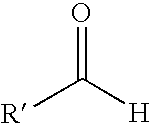Detergent composition for a low sulfur, low sulfated ash and low phosphorus lubricating oil for heavy duty diesel engines
a technology of phosphorus lubricating oil and sulfated ash, which is applied in the preparation of carboxylic compounds, liquid carbonaceous fuels, additives, etc., can solve the problems of not meeting emission requirements and adding to their mass
- Summary
- Abstract
- Description
- Claims
- Application Information
AI Technical Summary
Benefits of technology
Problems solved by technology
Method used
Image
Examples
example 1
[0117]A mixture of a metal salt of an alkyl hydroxyaromatic carboxylic acid and a metal salt of an alkyl phenol was prepared as described in U.S. Pat. No. 6,162,770 and a metal salt of a Mannich condensation product was prepared as in described U.S. Pat. No. 5,370,805 for determining the detergency performance of the detergent composition employed in the low sulfur, low sulfated ash and low phosphorus lubricating oil composition of the present invention.
[0118]Comparative Formulations A and B and Test Formulation C contained an ashless dispersant, an anti-oxidant, a viscosity index improver, a medium overbased alkyl phenate, an anti-wear agent and a foam inhibitor. Base oil was used to make-up a 100 percent of each of Comparative Formulations A and B and Test Formulation C. Comparative Formulations A and B and Test Formulation C are given in more detail in Table I below.
[0119]The detergency performance of Test Formulation C containing the detergent composition of the present inventio...
example 2
Panel Coker Test
[0126]The Panel Coker Test was used to evaluate the tendency of Test Formulation C compared to Comparative Formulations A and B to form carbon deposits when in contact with a metallic surface at high temperature. Samples, 300 grams, of Comparative Formulations A and B and Test Formulation C were heated in a sump and intermittently projected by means of a rotating oil stirrer on an aluminum test plate heated at high temperature. The amount of deposit was weighed at the end of the test. The lower the number the better the detergent. Viscosity increase at 40° C. and varnish rating were also recorded.
[0127]The results of the Panel Coker Test are summarized in Table III below.
[0128]
TABLE IIIPanel CokerFormulationTestComparative AComparative BTest CDeposit66649(mg)Carbon36272(%)Varnish3.66.38.6(Rating)Increase in314521Viscosity at 40° C.(%)
[0129]The results obtained in the Panel Coker Test summarized above in Table III show that the Test Formulation C containing the deterg...
PUM
| Property | Measurement | Unit |
|---|---|---|
| weight percent | aaaaa | aaaaa |
| lubricating viscosity | aaaaa | aaaaa |
| weight | aaaaa | aaaaa |
Abstract
Description
Claims
Application Information
 Login to View More
Login to View More - R&D
- Intellectual Property
- Life Sciences
- Materials
- Tech Scout
- Unparalleled Data Quality
- Higher Quality Content
- 60% Fewer Hallucinations
Browse by: Latest US Patents, China's latest patents, Technical Efficacy Thesaurus, Application Domain, Technology Topic, Popular Technical Reports.
© 2025 PatSnap. All rights reserved.Legal|Privacy policy|Modern Slavery Act Transparency Statement|Sitemap|About US| Contact US: help@patsnap.com

